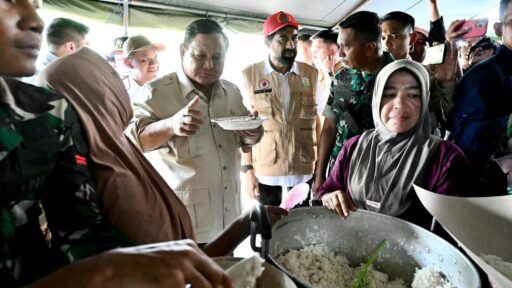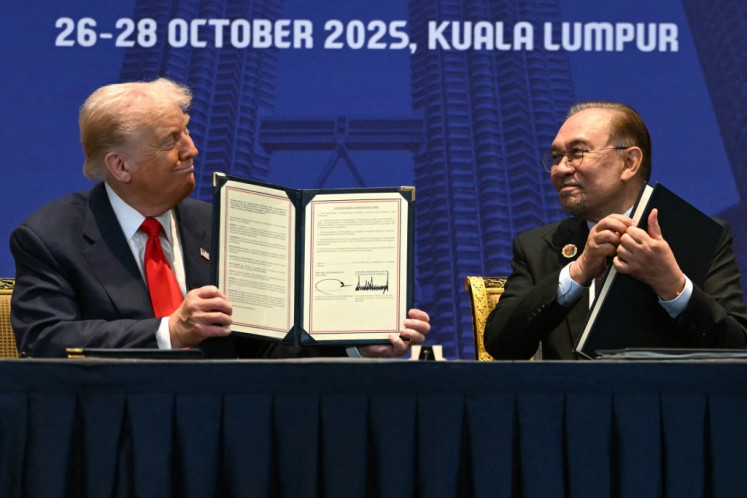Popular Reads
Top Results
Can't find what you're looking for?
View all search resultsPopular Reads
Top Results
Can't find what you're looking for?
View all search resultsOur ocean energy resource ' what exactly is it?
Do you want to know what free energy you have in your oceans? Letâs take a look at the ocean energy resource and metocean (the combined effects of meteorological weather conditions and oceanic tidal and global current flows) conditions around the worldâs largest archipelago
Change text size
Gift Premium Articles
to Anyone
D
o you want to know what free energy you have in your oceans? Let's take a look at the ocean energy resource and metocean (the combined effects of meteorological weather conditions and oceanic tidal and global current flows) conditions around the world's largest archipelago.
We will do this to identify the main tidal flows in the Indonesian seas and around the archipelago and identify areas where metocean conditions, especially waves, might have a significant impact on future ocean energy power-generation developments.
As most of us know, second only to Canada, Indonesia has one of
the world's largest coastlines. The seas around Indonesia are varied in their nature in terms of depths, currents and metocean conditions, as are the waves.
To the south of Sumatra and Java is the Indian Ocean, with very deep waters and typically large oceanic wave conditions.
In contrast, the Java Sea, north of Java, is relatively shallow (less than 100 meters), with much more benign wave conditions and a tidal dominance to the currents.
Further east, passing through the deep Makassar Strait (between Borneo and Sulawesi) are currents of global significance, forming part of what is known internationally as the 'Indonesian throughflow', a transport of Pacific Ocean water to the Indian Ocean.
Of more relevance to this are the tidal conditions in the shallower waters (generally less than 100 m depth) off the coastline of Indonesia. Using numerical models, merged with satellite data, we can determine that the dominant tidal constituents vary across the Indonesian seas, which lead to finding some areas where tides are predominantly daily and, in other areas, where they are twice daily.
In addition to reviews of existing literature, analysis of metocean conditions is required and therefore 30 years of six-hourly wave height data can be extracted from a wave forecast model that is operated by the ECMWF (European Centre for Medium-Range Weather Forecasting). Across much of the areas of interest for tidal energy, e.g. the shallower areas north of the island of Java and along the eastern coast of Sumatra and the chain of islands further to the east (e.g. Bali, Lombok, etc), wave conditions are found to be benign.
From an installation and long-term maintenance standpoint, the only areas of real concern would be those that may be exposed to waves from the Indian Ocean, for example near the entrances to a number of straits, like the Sunda Strait, and also at the northern tip of Sumatra at Bandah Aceh.
The seas around Indonesia are covered by two regional tidal models; the China Seas model and the North Australia model ' with the remaining areas covered by the Pacific and Indian Ocean tidal models. There are a number of previous studies that contain useful information on Indonesian tidal currents, which are relevant for assessing tidal resources.
However, these studies do not cover all Indonesian waters and many focus on different aspects of ocean science. Therefore, rather than rely on these previous studies, one should use them only as supporting evidence for the assessment of one's own tidal resource.
The tidal model used by our team to assess the Indonesian tidal resource was from the University of Oregon and combined computer numerical modeling with satellite measurement of tidal heights.
This tidal model is, in fact, a suite of tidal models giving different levels of fidelity for different regions of the world's oceans.
There are a number of other published reports relevant to Indonesia's oceans from 2011 onwards. The purpose of reviewing such literature was also to obtain information on the current cost estimates for various sized tidal arrays, identifying how much equipment (e.g. the very large turbine support structures) can be manufactured, assembled, tested, installed and commissioned in Indonesia; estimates of future offshore installation vessel costs and present and future electricity prices in Indonesia.
Cost estimates for tidal turbine arrays have been somewhat dynamic over time as the tidal industry has matured and as more complete and detailed information on costs has been prepared for arrays being deployed during the recent past, immediate and next few years.
The most up-to-date information available is found when applying the latest Renewable UK Tidal Industry responses to UK government consultation on future prices for renewable energy, as well as information from other tidal projects as the basis of pragmatic cost estimates.
Many factors will have an influence on the way Indonesia decides how best it should regulate and encourage tidal energy power-generation developers using the fiscal and monetary policy instruments it has at its disposal.
The sources of electricity in Indonesia vary greatly by province, with the most densely populated areas in Sumatra-Java-Bali obtaining electricity from the national grid, which is powered mainly by the state electricity company, PLN's, large fossil-fuelled power stations, while outlying provinces rely on diesel-fuelled generators, resulting in the cost of energy in remote provinces being up to five times as high as in the main, densely populated areas.
It is clear that high levels of government subsidy are being applied in support of fuel for power generation in remote areas.
Therefore, the focus should be on enabling renewable energy projects in remote areas and broadly encouraging the use of renewable energy to improve the country's carbon footprint, while at the same time reducing the government's subsidy cost for fossil-fuel energy generation for those areas.
There are a range of regulatory differences in Indonesia between projects larger than 10 MW capacity and those smaller than 10 MW, covering feed-in tariffs, environmental and consenting processes, as well as ownership issues.
These differences may affect the future size and designs of tidal energy projects for Indonesia. However, it should be said that the new Indonesian government appears to be very committed to supporting a range of low-carbon projects.
Michael J. Spencer is group chairman & CEO of SBS Intl Ltd, which operates in marine and subsea development engineering. Stephen Spall is a global metocean specialist and has a PhD in oceanography from the University of Southampton.










